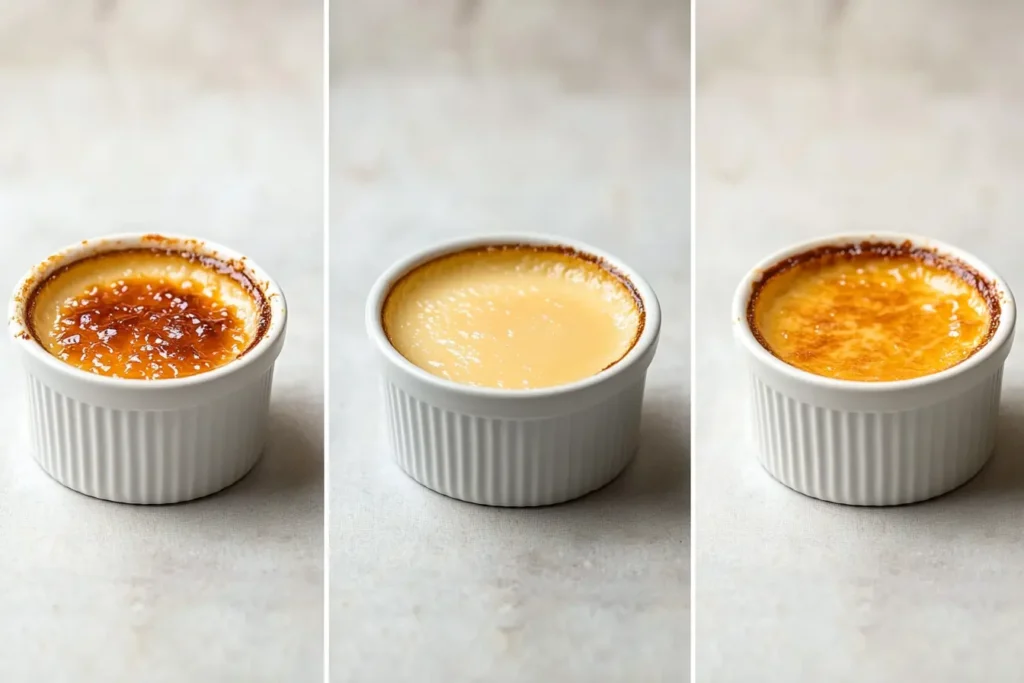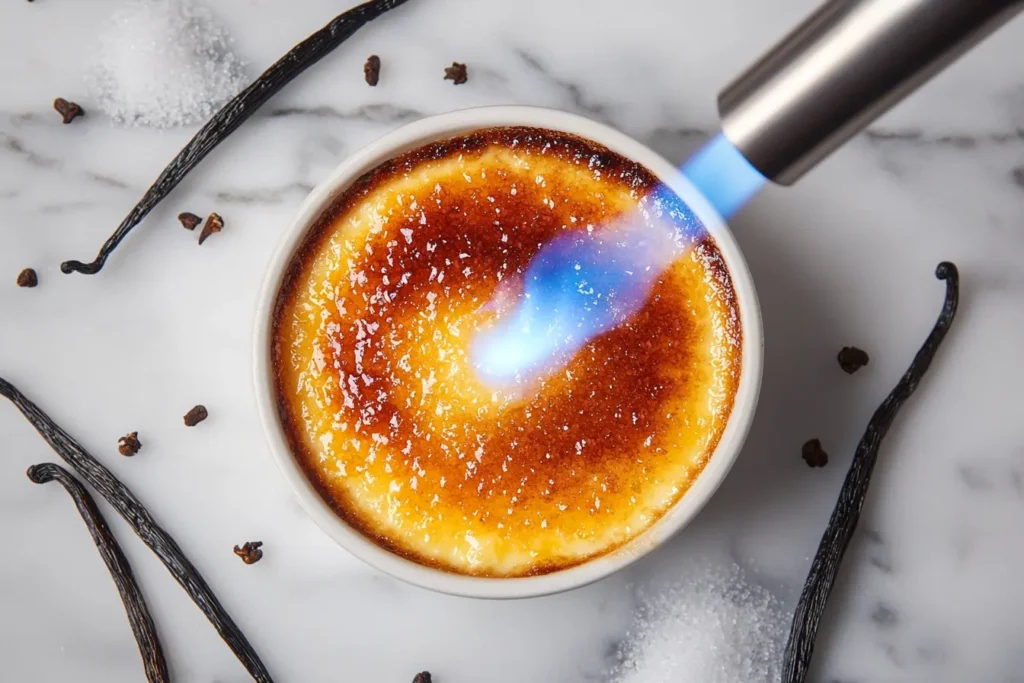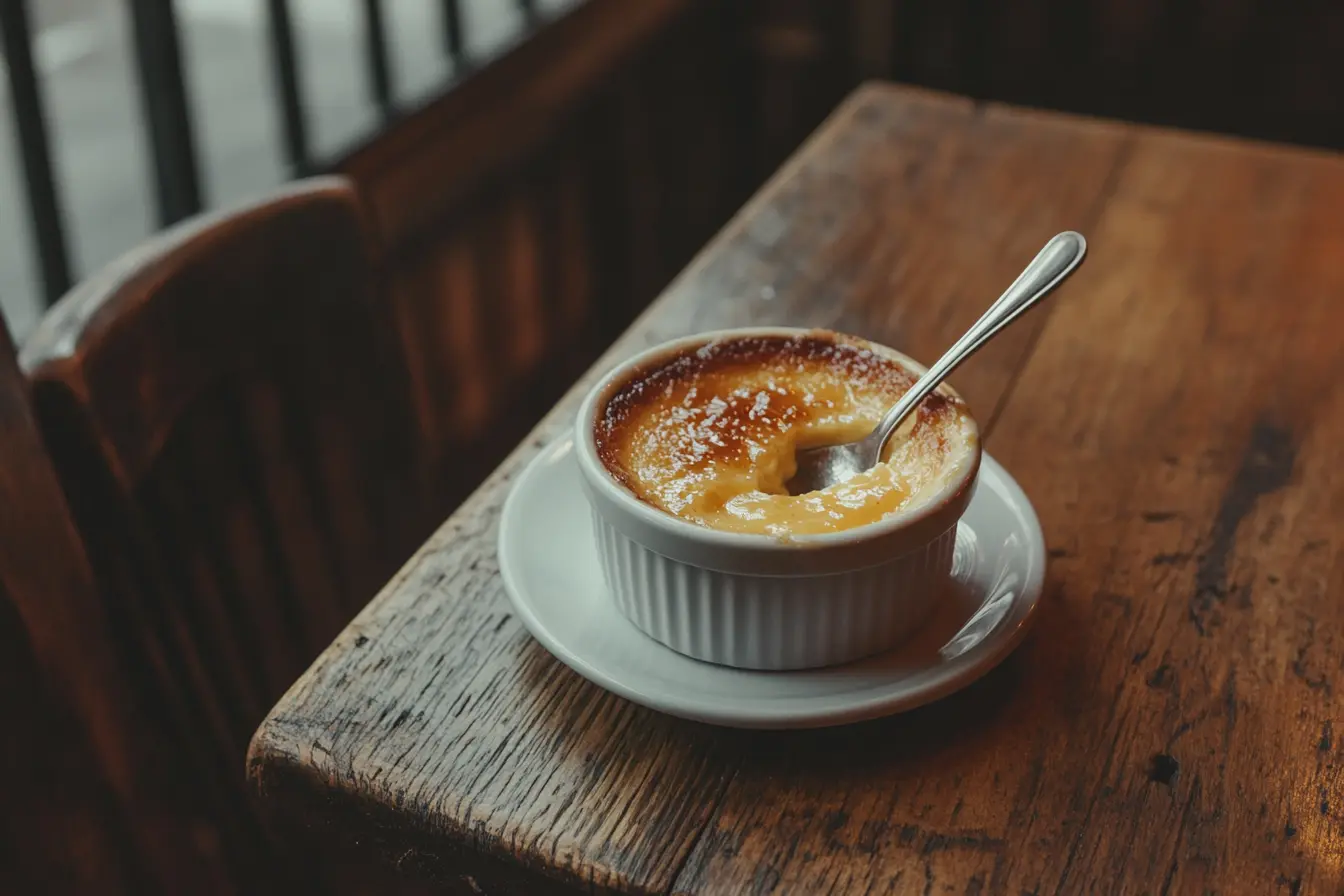Introduction
Few desserts are as luxurious, delicate, and satisfying as crème brûlée. With its silky vanilla custard hidden beneath a crisp caramelized sugar crust, it’s no wonder this classic French dessert has stood the test of time. But, what is the secret of crème brûlée?
The magic lies in the balance of flavors and textures, precise baking techniques, and the perfect caramelization of sugar. From choosing the right ingredients to mastering the water bath technique, every step plays a role in crafting this iconic treat.
In this article, we’ll uncover the secrets behind crème brûlée, explore common mistakes to avoid, and even dive into creative flavor variations. Whether you’re a beginner or an experienced baker, you’ll learn how to achieve a restaurant-quality crème brûlée right in your kitchen.
Let’s start by understanding what makes this dessert so unique.
The Essence of Crème Brûlée
What Makes Crème Brûlée Special?
At first glance, crème brûlée seems like a simple dessert—just a mix of cream, egg yolks, sugar, and vanilla. But the magic happens in how these ingredients are combined and cooked. The result is a dessert that’s:
- Rich and Creamy: The custard base is smooth, velvety, and infused with vanilla.
- Crisp and Caramelized: The torched sugar topping adds a satisfying crunch that contrasts the softness underneath.
- Delicately Balanced: It’s not too sweet, allowing the natural vanilla and caramel notes to shine.
The contrast between creamy and crunchy, warm and cold, is what makes crème brûlée an irresistible experience.
The Key Elements of Crème Brûlée’s Flavor & Texture
To understand what is the secret of crème brûlée, we need to break down the key elements that define its taste and texture:
- Egg Yolks: They create the smooth, rich texture of the custard.
- Heavy Cream: This is what makes the custard silky and decadent.
- Vanilla: Whether using vanilla beans, extract, or paste, this is the heart of crème brûlée’s flavor.
- Sugar: Used in both the custard and the topping, sugar adds sweetness and caramelization.
- Caramelized Sugar Crust: The signature golden, glass-like topping gives the dessert its iconic crunch.
Each of these components must be perfectly balanced to create the ultimate crème brûlée experience.
The Science Behind the Perfect Crème Brûlée
Many people ask, what is the secret of crème brûlée? The answer lies in the science of its ingredients and precise cooking techniques. Achieving that perfect creamy custard with a crisp caramelized top depends on temperature control, ingredient quality, and careful technique.
The Importance of the Right Ingredients
Crème brûlée may have a short ingredient list, but each component plays a crucial role in its flavor and texture:
- Heavy Cream: This gives the custard its rich, velvety texture. Using anything lower in fat can make it too runny.
- Egg Yolks: The yolks help thicken the custard, creating that smooth and creamy consistency.
- Vanilla: High-quality vanilla beans or pure vanilla extract add depth to the custard’s flavor.
- Sugar: White sugar is best for the custard base, while coarser sugars like turbinado or demerara are ideal for caramelizing.
Using fresh, high-quality ingredients makes a noticeable difference in the final dessert.
The Role of Temperature and Baking Techniques
One of the biggest secrets to perfect crème brûlée is baking at the right temperature. Too high, and the custard will curdle; too low, and it won’t set properly.
- Use a Water Bath (Bain-Marie): This ensures gentle, even cooking and prevents the custard from scrambling.
- Slow Baking: A low temperature (around 300°F/150°C) allows the custard to cook gradually, creating a silky texture.
- Proper Cooling: Let the custard chill for at least 4 hours (preferably overnight) to develop its signature smoothness.
Mastering these steps will elevate your crème brûlée from good to exceptional.

Mastering the Caramelized Sugar Topping
A flawless crème brûlée isn’t just about the custard—the caramelized sugar crust is just as important. That first crack of a perfectly torched topping is part of what makes this dessert so special.
Choosing the Right Sugar for the Crisp Top
The secret to a perfect crisp sugar topping lies in choosing the right type of sugar.
- White Granulated Sugar: Melts evenly and creates a smooth, glassy caramel layer.
- Turbinado or Demerara Sugar: These coarser sugars produce a thicker, crunchier topping with a deeper caramel flavor.
- Brown Sugar: While it adds richness, it contains moisture and can make the topping sticky rather than crisp.
For the best results, a thin, even layer of white sugar is ideal, though a mix of white and turbinado can give the crust extra texture.
Torch vs. Broiler: The Best Way to Caramelize
Should you use a kitchen torch or the oven broiler to caramelize the sugar? Both methods work, but they create slightly different results.
- Using a Torch (Best Method):
- Provides precise heat control
- Ensures even caramelization without overcooking the custard
- Creates a beautiful golden-brown crust in seconds
- Using a Broiler:
- Works well if you don’t have a torch
- Requires careful watching to prevent burning
- Can sometimes heat the custard too much, affecting its texture
For the best crème brûlée experience, a kitchen torch is highly recommended.

Common Mistakes & How to Avoid Them
Even experienced bakers sometimes struggle with crème brûlée. If you’ve ever wondered, what is the secret of crème brûlée and why yours isn’t turning out quite right, it may be due to one of these common mistakes. Let’s explore what can go wrong and how to fix it.
Preventing a Watery or Grainy Custard
The heart of a perfect crème brûlée is its smooth, creamy custard. If yours turns out too runny or grainy, one of these issues could be the cause:
- Overheating the Cream: If you add eggs to cream that’s too hot, you risk scrambling the eggs. Always temper the eggs by slowly whisking in warm cream to avoid curdling.
- Skipping the Water Bath: Baking without a bain-marie (water bath) can lead to uneven cooking, making the custard too firm in some areas and too soft in others. Always place your ramekins in a hot water bath before baking.
- Incorrect Baking Temperature: Too high a temperature can cause the custard to curdle, while too low a temperature won’t set it properly. Stick to a steady 300°F (150°C) and bake until the edges are set but the center still jiggles slightly.
Fixing a Cracked or Burnt Sugar Topping
The sugar crust is a defining feature of crème brûlée, but it can easily go wrong. If it cracks, burns, or melts into the custard, here’s what to do:
- Don’t Torch Too Long: Holding the flame too close or for too long can burn the sugar instead of caramelizing it. Keep the torch 2–3 inches away and move it in a circular motion for an even finish.
- Use the Right Sugar: Coarse sugars like turbinado or demerara caramelize slower and create a thicker, crunchier crust, while granulated sugar melts faster for a thinner topping.
- Torch Just Before Serving: If you caramelize the sugar too early, it can absorb moisture from the custard, losing its crunch. The best practice is to torch it right before serving.
By mastering these techniques, you’ll avoid common pitfalls and achieve a perfect crème brûlée every time.
Unique Variations & Flavor Twists
While classic vanilla crème brûlée is timeless, creative bakers love experimenting with flavor variations. If you’ve already mastered the traditional version, why not try something new?
Beyond Classic Vanilla: Popular Flavor Infusions
What is the secret of crème brûlée’s versatility? The custard base acts as a perfect canvas for a variety of flavors:
- Chocolate Crème Brûlée: Adding melted dark chocolate to the custard creates a rich, indulgent twist.
- Coffee Crème Brûlée: Infusing the cream with espresso adds a bold, slightly bitter contrast to the sweetness.
- Citrus Zest Crème Brûlée: A touch of lemon, orange, or lime zest can brighten the flavor.
- Matcha Crème Brûlée: Green tea powder gives it a subtle earthy, slightly bitter note that pairs beautifully with the caramelized sugar topping.
- Grand Marnier Crème Brûlée: A splash of orange liqueur adds a sophisticated depth of flavor.
Dietary Adaptations: Vegan & Dairy-Free Crème Brûlée
If you’re looking for a dairy-free or plant-based option, there are great alternatives:
- Coconut Cream Crème Brûlée: Substitute heavy cream with full-fat coconut milk for a tropical twist.
- Almond Milk Crème Brûlée: This option provides a lighter texture but still delivers the signature custard feel.
- Egg-Free Custard: Using cornstarch or agar-agar can help thicken the custard in place of eggs.
Experimenting with flavors and dietary adaptations allows you to put a unique spin on this classic French dessert.
💡 Want to learn more about classic desserts? Check out other pastry recipes and explore new techniques to elevate your baking! 🍮✨
FAQs – What People Also Ask
Many people wonder, what is the secret of crème brûlée and how to achieve that perfect creamy custard with a crisp caramelized top. Here are some of the most frequently asked questions about this iconic French dessert.
What Is the Secret of Crème Brûlée’s Perfect Texture?
The key to a silky, smooth custard lies in low and slow baking. Cooking at 300°F (150°C) in a water bath prevents overheating, which can cause the custard to curdle. Also, always temper the eggs by gradually adding warm cream to avoid scrambling them.
Why Does Crème Brûlée Need a Water Bath?
A bain-marie (water bath) ensures gentle, even heat distribution. Without it, the custard can bake unevenly, leading to a grainy or rubbery texture instead of a silky-smooth finish.
What Sugar Is Best for Caramelizing Crème Brûlée?
The best sugar for a crisp caramelized topping is white granulated sugar, as it melts evenly. However, if you prefer a thicker, crunchier crust, try turbinado or demerara sugar.
Can I Make Crème Brûlée Without a Torch?
Yes! While a kitchen torch is the best method, you can also use an oven broiler. Simply place the ramekins under high heat for 1–2 minutes, watching closely to prevent burning. However, this method may heat the custard too much, slightly altering its texture.
Conclusion – A Dessert Worth Mastering
Now that we’ve explored what is the secret of crème brûlée, it’s clear that this deceptively simple dessert requires precision, patience, and the right technique. But once mastered, it’s one of the most elegant and rewarding desserts you can make.
Why Crème Brûlée Remains a Timeless Classic
- The contrast between creamy custard and crisp caramelized sugar makes every bite irresistible.
- Its simple ingredient list allows the quality of flavors to shine.
- It’s a show-stopping dessert that impresses guests and adds a touch of elegance to any meal.
- With so many flavor variations, you can customize it to your taste.
Ready to Try It?
If you’ve never made crème brûlée before, now is the perfect time to start. With the right ingredients, proper technique, and a little practice, you’ll be cracking into a perfectly caramelized, velvety custard in no time.
So, the next time someone asks, what is the secret of crème brûlée, you’ll know that the answer lies in precision, balance, and a touch of culinary magic! 🍮✨
💡 Want to explore more classic desserts? Check out our other pastry guides and start mastering timeless recipes today!

